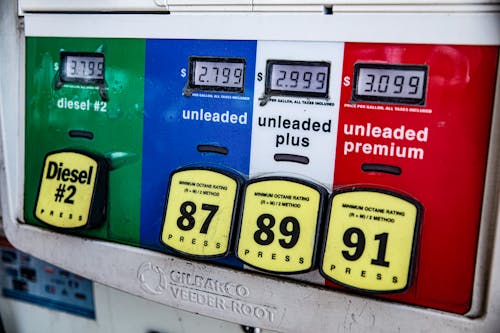Introduction: Why Every Prepper Needs a Fuel Plan and Understand How to Store Fuel Safely
When the power grid fails or supply chains collapse, fuel turns from an everyday commodity into a lifeline. Whether you’re running a generator, keeping a vehicle mobile, or heating a home off-grid, fuel storage is essential to real preparedness.
But not all fuel behaves the same. Gasoline and diesel each have different storage requirements, shelf lives, and hazards. Knowing how to store both safely could be the difference between staying powered up or sitting in the dark.
This guide walks you through how to store fuel safely for emergencies, covering everything from container types and stabilizers to long-term maintenance and legal limits.
1. Understanding the Difference Between Gasoline and Diesel

Before storing either, it’s critical to know what you’re working with and how to store fuel safely.
| Property | Gasoline | Diesel |
|---|---|---|
| Volatility | Very high (evaporates and ignites easily) | Low (heavier, ignites under compression) |
| Shelf life (untreated) | 3–6 months | 6–12 months |
| Shelf life (treated) | Up to 12 months | Up to 2 years or longer |
| Storage risk | Vapors, fire hazard | Microbial growth, gelling in cold temps |
| Ideal container | Red gasoline-rated can | Yellow diesel-rated can |
Gasoline is more volatile, which means it evaporates and ignites far more easily. Diesel, on the other hand, is more stable but can develop microbial growth (“diesel algae”) and thicken in cold weather. Both require care, but for different reasons.
2. Choosing the Right Containers
Approved fuel containers are your first line of defense.
- Gasoline: Use red containers labeled and rated for gasoline (DOT / EPA approved). Avoid reusing milk jugs or random plastic bottles—they’ll melt or leak vapors.
- Diesel: Store in yellow containers marked “Diesel Fuel.” These are thicker and resist the solvents in diesel.
Metal vs Plastic
- Plastic: Lightweight, corrosion-resistant, ideal for rotating small amounts (1-5 gallons).
- Metal: Durable and less permeable, but heavier and prone to rust if stored on concrete or in damp areas.
Keep containers sealed tightly and stored upright to prevent leaks and vapor escape.
3. Where to Store Your Fuel
Fuel should always be kept in a cool, ventilated, detached structure—never inside a home or attached garage.
Best practices:
- Keep out of direct sunlight and away from heat sources or sparks.
- Maintain temps under 80 °F when possible.
- Elevate containers on wooden pallets or shelves to reduce condensation.
- Store away from fertilizer, paint thinner, or other reactive chemicals.
Even diesel, which doesn’t ignite as easily, should be isolated—its fumes are toxic and can corrode metals over time.
4. Label, Date, and Rotate
Fuel doesn’t last forever. Mark every container with:
- Date purchased
- Type of fuel
- Additives used (stabilizer, biocide, etc.)
Create a simple log sheet near your storage area. Rotate gasoline every 6 months, diesel every 12 months. Use older fuel in lawn mowers, generators, or vehicles before it degrades.
5. Using Stabilizers and Additives
Gasoline
Gasoline oxidizes quickly. Adding a stabilizer like STA-BIL® or PRI-G® right after purchase can extend shelf life up to a year. Mix gently before sealing the container.
Diesel
Diesel benefits from biocides (to prevent microbial growth) and anti-gel additives in colder climates.
Recommended products include Biobor JF® and Howes Diesel Treat®.
Pro tip: Always mix additives when the fuel is fresh. Adding them later helps only marginally.
6. Long-Term Storage Options
For larger quantities, consider:
- Fuel drums or barrels (30–55 gal) – ideal for homesteads with generators or tractors.
- Fuel cubes or tanks – metal or double-walled plastic, with venting and secondary containment trays.
- Underground tanks (advanced users only) – must meet local fire codes; consider professional installation.
Always ground metal containers during filling to prevent static sparks. Keep fire extinguishers nearby, rated for Class B (flammable liquids).
7. Temperature and Weather Factors
- Gasoline: Sensitive to heat; vapor pressure builds quickly in warm environments. Never store in sunlight or car trunks.
- Diesel: Susceptible to gelling in cold weather. If you live in a northern climate, choose winter-blend diesel or treat it with anti-gel additives.
If you expect extreme conditions, split your storage: keep a portion in a temperature-moderated shed and another in a shaded outdoor tank.
8. Legal Limits and Safety Codes
Most U.S. jurisdictions allow up to 25 gallons of gasoline or diesel at home before requiring a permit. Check local fire codes and homeowner association rules.
- Always post “No Smoking / Flammable Liquid” signs.
- Ensure containers are at least 50 feet from dwellings.
- In Europe, limits vary (typically 20–60 liters / 5–15 gallons per vehicle or property).
When in doubt, contact your local fire department—they’ll often provide free safety guidance.
9. Handling and Refilling Procedures
When transferring fuel:
- Ground both source and receiving containers.
- Use an anti-static transfer pump (avoid plastic funnels).
- Fill slowly; leave expansion space.
- Wipe up spills immediately.
- Keep a Class B fire extinguisher close by.
Never refuel a generator or vehicle while running or hot.
10. Dealing with Old or Contaminated Fuel
Gasoline
If it smells sour or darkens, it’s oxidized. Don’t pour it into engines you care about. Use small amounts in yard equipment, or take it to a hazardous-waste collection center.
Diesel
If you see black slime or sludge at the bottom of the container, that’s microbial growth. Filter or discard it safely. Local recycling centers usually accept contaminated diesel.
11. Real-World Example: The Backyard Fuel Station
Let’s say you’re running a small suburban homestead with a backup generator and two vehicles. Here’s a practical setup for how to store fuel safely:
- Gasoline: Three 5-gallon red cans stored in a ventilated shed on wood pallets, each treated with stabilizer. Rotated every 6 months for use in the generator and mower.
- Diesel: One 15-gallon yellow tank feeding a small backup heater. Treated with biocide and topped up twice a year.
- Safety: Each container dated, log sheet on wall, fire extinguisher nearby, “No Smoking” signage posted.
This setup covers several days of emergency power, vehicle use, and heating, with minimal risk and maximum readiness.
12. FAQs
Q: How long can I store gasoline and diesel before it goes bad?
A: Gasoline lasts about 3–6 months untreated and 12 months with stabilizer. Diesel can last 6–12 months untreated and up to 2 years with proper biocides and storage.
Q: Can I mix old and new fuel?
A: In small amounts, yes. Blend a little old fuel with fresh to burn through it. But never rely on stale fuel for emergency power.
Q: Can I store gasoline and diesel in the same shed?
A: Yes, but separate them clearly, label each, and ensure good ventilation. Keep ignition sources far away.
Q: What’s safer for long-term prepping—gasoline or diesel?
A: Diesel wins for long-term stability and lower volatility, but gasoline is easier to find and works in more small engines. The best preppers store both.
Q: How should I dispose of bad fuel?
A: Contact your city’s hazardous-waste program or recycling center. Never pour fuel into soil or drains.
Q: What about propane or kerosene?
A: They’re excellent alternatives for cooking and heating, but store differently—pressurized tanks or sealed containers only. Never mix them with liquid fuels.
Conclusion: Safe Fuel, Steady Power
When emergencies hit, fuel can’t be an afterthought. Whether you rely on gasoline for your generator or diesel for your heater or truck, the same principle applies: store it safely, label it clearly, and rotate it regularly.
Handled correctly, a few cans of treated fuel could keep your home lit, warm, and mobile when the world grinds to a halt. That’s what true readiness looks like.
Get your free “Emergency Fuel & Power Checklist” from Backyard Bug Out.
It includes fill-date templates, additive charts, and a printable rotation tracker for your home fuel station.
If you have any questions about how to store fuel safely, leave a comment!
